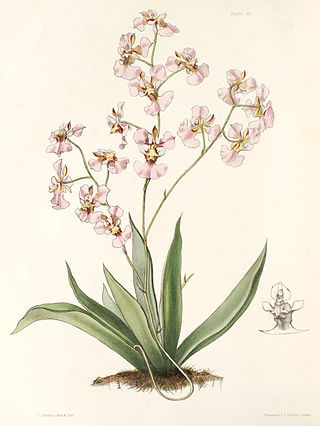
The Caribbean Sea is a sea of the North Atlantic Ocean in the tropics of the Western Hemisphere, located south of the Gulf of Mexico and southwest of the Sargasso Sea. It is bounded by the Greater Antilles to the north from Cuba to Puerto Rico, the Lesser Antilles to the east from the Virgin Islands to Trinidad and Tobago, South America to the south from the Venezuelan coastline to the Colombian coastline, and Central America and the Yucatán Peninsula to the west from Panama to Mexico. The geopolitical region around the Caribbean Sea, including the numerous islands of the West Indies and adjacent coastal areas in the mainland of the Americas, is known as the Caribbean.

Quassia is a plant genus in the family Simaroubaceae. Its size is disputed; some botanists treat it as consisting of only one species, Quassia amara from tropical South America, while others treat it in a wide circumscription as a pantropical genus containing up to 40 species of trees and shrubs.

The Greater Antilles is a grouping of the larger islands in the Caribbean Sea, including Cuba, Hispaniola, Puerto Rico, and Jamaica, together with Navassa Island and the Cayman Islands. Seven island states share the region of the Greater Antilles, with Haiti and the Dominican Republic sharing the island of Hispaniola. Together with the Lesser Antilles, they make up the Antilles, which along with the Lucayan Archipelago, form the West Indies in the Caribbean region of the Americas.

Pimenta is a genus of flowering plants in the myrtle family, Myrtaceae described as a genus in 1821. It is native to Central and South America, Mexico, and the West Indies.

Koanophyllon is a genus of plants in the family Asteraceae. They are perennials and shrubs and are native to South America, Central America, the West Indies, Mexico, with a few species range extending into the United States. The flowers are white to pinkish.
Juglans jamaicensis, the West Indian walnut, nogal, or palo de nuez, is a species of walnut in the Juglandaceae family native to the Greater Antilles.

Picrasma excelsa is a species of Picrasma in the family Simaroubaceae. It is found in Cuba, the Dominican Republic, Haiti, Jamaica, Puerto Rico, Saint Vincent and the Grenadines, and Venezuela. It is threatened by habitat loss.

Renealmia is a plant genus in the family Zingiberaceae. Its members are native to tropical Africa and tropical America. In Peru, fruits and tubers are sources of indigenous dyes. and indigenous medical treatments for leishmania and malaria In Colombia, it is used to treat snakebite. Bracts and leaves can serve as phytotelmata, retaining small quantities of water that offer habitat for other organisms.
Sideroxylon cubense is a species of plant in the family Sapotaceae. It is native to Cuba, Hispaniola, the Leeward Islands, and Puerto Rico.

Billbergia pyramidalis, commonly known as the flaming torch and foolproof plant, is a species of bromeliad that is native to northern South America and parts of the Caribbean. It was first described by John Sims, and got its current name by John Lindley.
The Caribbean bioregion is a biogeographic region that includes the islands of the Caribbean Sea and nearby Atlantic islands, which share a fauna, flora and mycobiota distinct from surrounding bioregions.

Tolumnia variegata, commonly known as the harlequin dancing-lady orchid or variegated oncidium in English and as angelito or angelitos in Spanish, is a species of orchid native to the Caribbean.
Calliandra haematomma is a species of flowering plants of the genus Calliandra in the family Fabaceae. Calliandra pilosa is a synonym of C. haematomma var. glabrata.
Chione is a monotypic genus of flowering plants in the family Rubiaceae containing the single species Chione venosa. It is native to the neotropics, occurring in most of Mexico, and throughout Central America, the Caribbean, Colombia, Ecuador, and Peru. It is typically a tree growing 10 to 20 meters tall. In harsh habitats, it may be dwarfed and shrubby. It has no known economic use.

Catesbaea is a genus of flowering plants in the family Rubiaceae. It occurs in the West Indies, The Bahamas, and the Florida Keys. The genus is named in honour of English naturalist Mark Catesby.

Comocladia is a genus of flowering plants in the cashew family, Anacardiaceae. It is native to the Americas, where it is distributed in Mexico, Central America, and the Caribbean. Species are known commonly as maidenplums. The term guao is commonly used to refer to Comocladia species in Cuba and the Dominican Republic.

Mosiera is a genus of shrubs and small trees in the family Myrtaceae, first described as a genus in 1933. It is native to Mexico, Guatemala, the West Indies, Brazil, and Florida.

Consolea moniliformis is a species of cactus that is native to the Greater Antilles, on Cuba, Hispaniola, and Puerto Rico.

Pinochia corymbosa, commonly known as Bejuco de San Juan, is a species of flowering plant in the family Apocynaceae, native to the Greater Antilles. It was first described by Nikolaus Joseph von Jacquin in 1760 as Echites corymbosus.













